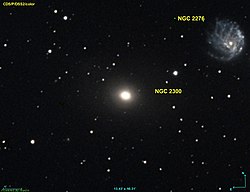| NGC 2300 | |
|---|---|
 NGC 2300 next to nearby galaxy NGC 2276 | |
| Observation data (J2000[1] epoch) | |
| Constellation | Cepheus |
| Right ascension | 07h 32m 20.5s[1] |
| Declination | +85° 42′ 31.9″[1] |
| Redshift | 0.00641[1] |
| Heliocentric radial velocity | 1,917 km/s[1] |
| Distance | 90.2 ± 6.3 Mly (27.67 ± 1.94 Mpc)[2] |
| Group or cluster | Arp 114 |
| Apparent magnitude (V) | 10.76[3] |
| Absolute magnitude (V) | −22.0[3] |
| Characteristics | |
| Type | SA00[3] |
| Other designations | |
| 2MASX J07322048+8542319, Arp 114, UGC 3798, MCG +14-04-031, PGC 21231[4][1] | |
NGC 2300 is a lenticular galaxy in the constellation Cepheus.[2] Its velocity with respect to the cosmic microwave background is 1876 ± 7 km/s, which corresponds to a Hubble distance of 90.2 ± 6.3 Mly (27.67 ± 1.94 Mpc).[2] However, 11 non redshift measurements give a distance of 131.98 ± 21.75 Mly (40.464 ± 6.668 Mpc).[5] The galaxy was discovered in 1871 by French astronomer Alphonse Borrelly using an 18 cm telescope.[4]
Together with NGC 2276, they form the 114th object in Halton Arp's Atlas of Peculiar Galaxies.[6]
According to the SIMBAD database, NGC 2300 is an Active Galaxy Nucleus Candidate, i.e. it has a compact region at the center of a galaxy that emits a significant amount of energy across the electromagnetic spectrum, with characteristics indicating that this luminosity is not produced by the stars.[1]
One supernova has been observed in NGC 2300: SN 2024uai (type Ia-91bg-like, mag. 16.58).[7]
- ^ a b c d e f g "NGC 2300". SIMBAD. Centre de données astronomiques de Strasbourg. Retrieved 2019-02-25.
- ^ a b c "Your NED Search Results". ned.ipac.caltech.edu. Retrieved 2019-02-25.
- ^ a b c "Results for object NGC 2300 (NGC 2300)". NASA/IPAC Extragalactic Database. California Institute of Technology. Retrieved 2021-02-26.
- ^ a b "New General Catalog Objects: NGC 2300 - 2349". cseligman.com. Retrieved 2019-02-25.
- ^ "Distance Results for NGC 2300". NASA/IPAC EXTRAGALACTIC DATABASE. NASA. Retrieved 2 September 2024.
- ^ Arp, Halton (1966). "Atlas of Peculiar Galaxies". The Astrophysical Journal Supplement Series. 14: 1. Bibcode:1966ApJS...14....1A. doi:10.1086/190147.
- ^ "SN 2024uai". Transient Name Server. IAU. Retrieved 2 September 2024.